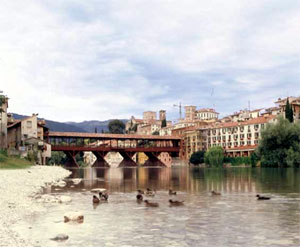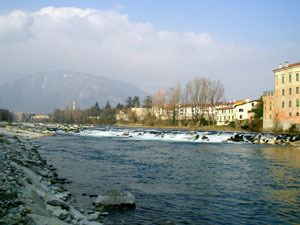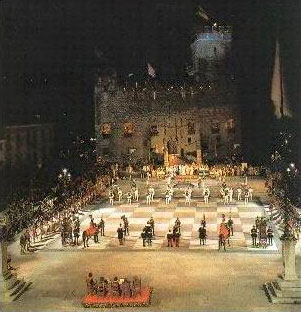Bassano sits in a stunning location by the River Brenta with
Monte Grappa in the background. It is about 35 kilometres north
east of Vicenza. The town's symbols are said to be the
Palladian bridge, white asparagus, ceramics and the Grappa
liqueur. I visited the town for the day in February 2005.  I really liked the location, the fresh air, the
fast flowing river and the picturesque bridge. If you like to be
slightly off the tourist track and would prefer a more rural
setting for short break or as a base for a touring holiday,
Bassano is ideal.
I really liked the location, the fresh air, the
fast flowing river and the picturesque bridge. If you like to be
slightly off the tourist track and would prefer a more rural
setting for short break or as a base for a touring holiday,
Bassano is ideal.
How to get there
The nearest airports are Treviso, used by Ryanair as its airport for Venice and Venice Marco Polo. You could hire a car from the airport. It is possible to reach Bassano by train on the Vicenzia – Trento or Padova – Bassano lines.
History
It is often assumed that the city takes its name from the well known liqueur Grappa. This is not the case; it is named after Monte Grappa. The mountain's name is said to originate from crapp or greep, meaning crag in an ancient pre-Latin language. The liqueur Grappa's name stems from grappolo, meaning a cluster of grapes.
Grappa liqueur has been produced in Bassano since 1779 when Bortolo Nardini bought a Grapperia on the Brenta River bank. Grappa is made from the by-products of wine making, the seeds, stems and skins. The company is still run by members of the Nardini family, accounting for around one quarter of annual grappa production.
Ponte Vecchia has become synonymous with Bassano.  The bridge
is first mentioned in the 11th century. The bridge has been
rebuilt several times due to flooding or destruction during wars.
It is still the original design by Palladio from 1569. The bridge
is built of wood, making it more resilient to the fast flowing
River Brenta.
The bridge
is first mentioned in the 11th century. The bridge has been
rebuilt several times due to flooding or destruction during wars.
It is still the original design by Palladio from 1569. The bridge
is built of wood, making it more resilient to the fast flowing
River Brenta.
There is a record of the city on St Mary's Hill from the 10th century. From the 14th to 18th century the city was under Venetian rule. It became well known for the manufacture of ceramics, wool, silk, iron and copper. The Remondini family ran one of the most up to date printing houses in Europe from the17th to the 19th century.
The Town Hall was first constructed in1405. Bartolomeo Ferranci installed the present clock mechanism in 1743. The interior walls are adorned by frescoes of 120 coats of arms.
White asparagus was first produced in the 16th century after Bassano experienced a hailstorm which destroyed the asparagus crop. The farmers dug up the part of the plant below the earth and discovered that it was so tender and delicious that they started to grow it underground permanently.
Parolini, a local nobleman, designed the Giardini Parolini in the early 19th century. In 1829 Parolini catalogued 3000 plant species in the garden.
During the First World War the Italians took a last stand against the Austrians in Monte Grappa where they entrenched themselves in tunnels and bunkers to repel the Austrian attackers. Over 12,000 Italian and 10,000 Austrian soldiers lost their lives in the numerous battles.
During the Second World War Italian partisans hid in Monte Grappa, organising raids on the main supply route from Germany to the German troops stationed in Italy. In 1944 the Germans took revenge by marching up the mountain behind women, children and elderly local inhabitants. Any partisans discovered or civilians suspected of assisting partisans were killed. There were public hangings and shootings with families forced to watch.
In 1946 the Italian prime minister awarded Basssano the gold medal for military valour. Every year the city commemorates these events during September.
The Museo degli Alpini was established in 1948 in memory of the Italian Alpine Troops It is located on the eastern side of the Ponte Vecchio. You have to enter it through a cafe. I found this rather confusing but the museum is down stairs to the left when you enter the cafe. Originally the collection was very small but has grown as more war relics have been gathered together. There are many original photos, uniforms and armoury.
Museo della Cermica is near the eastern side of the Ponte Vecchio. The building was constructed as the residence of Ferrari family, owners of a local silk factory. The entrance hall is adorned with a fresco by Giorgio Anseli. There are pieces of engraved ceramics from medieval times, Mainardi majolica pieces from the 17th and 18th century, along with modern pieces.
The Civic Musuem is one of the oldest in the Veneto region. It was built in1828 on the site of the convent of St Francis. It houses a collection of paintings by the Da Ponti family, Guariento and Magnasco, a collection of prints by the Remondini family. There is also an archaeological section and pieces by Antonio Canova.
Bassano boasts several churches. San Donato was built in 1208. It is claimed that St Francis of Assisi and St Anthony of Padua both stayed here during the third decade of the 13th century. The church was a hospital, run by Benedictine nuns in the 14th century, then a Fransican monastery during the 15th century. The church was restored in 1900, including work being done on the cell which was used by the two saints.
The Church of San Francesco was started in the mid 12th century, after the return of Ezzelino 11, the Stutterer, from the Holy Land. The Church of St John the Baptist was originally built in 1308 but reconstructed in the 18th century by local architect Giovanni Miazzi. Giambattista Piazzetti made the altarpiece of John the Baptist and Orzio Marinali created the statues of angels and the bas-reliefs.
The Cathedral of Holy Mary was a 10th century parish church in the original high part of the town. The present cathedral dates from the 17th century. The high altar piece and the painting of St Stephen are the work of Leandro di Ponte, and the sculptures are by Mainali. Di Giacomo Dacci made the organ and the three ceiling paintings are by Volpata.
Day trips
Marostica
Marostica is a 14th century medieval town where the original town
wall stands intact. It is best known as the “town of
chess”. Every second year a match, with people dressed in
elaborate costumes to portray the pieces, is played on the giant
chessboard below the castle. This takes place on the second
Friday, Saturday and Sunday every second year, when the year ends
in an even number. This commemorates the chess match played in
1454 when the victor was to win the hand in marriage of Lianora,
the daughter of the Lord of the Castle of Marostica. Two suitors,
Rinaldo d'Angarano and Vieti da Vallonara, had fallen in love
with Lianora and were to fight a duel to see how would marry
Lianora. The Lord forbade the duel and order decreed that the
victor of the chess match would marry Lianora. However all was
not lost for the defeated suitor, as he would marry Lianora's
younger sister, Oldrata. The period costumes are permanently
displayed in the Lower Castle. 
Marostica holds a Cherry Festival every year during May and June. There are kiosks in the streets selling a variety of cherries including morello, roame, marostagne and sander. There is an annual exhibition of comic cartoons in the town. Every July and August local craftsmen display their work the exhibition hall of the Lower Caste. There are some lovely walks through the surrounding hills.
Asola
Asola is a charming hilltop town, with a castle, a cathedral with a altar piece by Lorenzo Lotto and the 15th century Palazzo della Ragione. It was called the “city of one thousand horizons” by Giosue Carducci, because of all the fantastic views. It was much favoured by the Venetian nobility. Caterina Corona, the former Queen of Cyprus, lived here in the late 15th century. Robert Browning, the English poet, bought a house ere in the mid 17th century. Eleanora Duse, credited with being the greatest actress of the Italian stage was also a resident. The travel writer Freya Stark was brought up in Asolo and spent a lot of time here between her various expeditions. There is an antiques market every second weekend of the month, except during July and August.
Karen Bryan is an independent travel consultant and writer, specialising in less well known destinations in Europe. Her websites are: www.europealacarte.co.uk, www.europe-culture-activity-tours
